Car classification
Cars may be classified by a number of different criteria; however, comprehensive classification is elusive, because a vehicle may fit into multiple categories, or not completely satisfy the requirements for any. This article details the most commonly used systems of classification. Where applicable, the equivalent Euro NCAP classifications are shown. Car rental companies often use the ACRISS Car Classification Code. The United States Environmental Protection Agency (US EPA) has another set of classification rules based on interior passenger and cargo volumes.[1] A similar set of classes is used by the Canadian EPA.[2] In Australia, the Federal Chamber of Automotive Industries publishes its own classifications.[3]
Contents |
Classification
This is a table listing several different methods of car classification.
| American English | British English | Euro Car Segment[4] | Euro NCAP 1997 - 2009 | Euro NCAP[5] | Examples |
|---|---|---|---|---|---|
| Microcar | Microcar, Bubble car | A-segment mini cars | Supermini | Passenger car | Isetta, Smart Fortwo |
| Subcompact car | City car | Fiat 500, Daewoo Matiz, Peugeot 107, Toyota iQ | |||
| Supermini | B-segment small cars | Ford Fiesta, Volkswagen Polo, Ford Figo, Opel Corsa, Peugeot 207 | |||
| Compact car | Small family car | C-segment medium cars | Small family car | Ford Focus, Opel Astra, Toyota Auris, Volkswagen Golf, Chevrolet Cobalt | |
| Mid-size car | Large family car | D-segment large cars | Large family car | Ford Mondeo, Opel Insignia, Volkswagen Passat, Chevrolet Malibu | |
| Entry-level luxury car | Compact executive car | Alfa Romeo 159, BMW 3 Series, Lexus IS, Volvo S60, Audi A4, Cadillac CTS | |||
| Full-size car | Executive car | E-segment executive cars | Executive car | Ford Crown Victoria, Holden Commodore, Toyota Crown, Chrysler 300C, Chevrolet Impala | |
| Mid-size luxury car | Lexus GS, BMW 5 Series, Jaguar XF, Lincoln LS, Audi A6, Volvo S80, Cadillac CTS | ||||
| Full-size luxury car | Luxury car | F-segment luxury cars | - | Audi A8, Maserati Quattroporte, Lincoln Town Car, Mercedes S-Class, Cadillac DTS | |
| Sports car | Sports car | S-segment sport coupes | - | Chevrolet Corvette, Porsche 911, Ferrari 458 Italia, Nissan Z-car | |
| Grand tourer | Grand tourer | - | Jaguar XK, Ferrari 612 Scaglietti, Maserati GranTurismo | ||
| Supercar | Supercar | - | Bugatti Veyron, Ferrari Enzo, Pagani Zonda | ||
| Convertible | Convertible | - | BMW 6 Series, Mercedes CLK, Volvo C70, Volkswagen Eos, Chevrolet Camaro | ||
| Roadster | Roadster | Roadster sports | Roadster | Audi TT, Honda S2000, Lotus Elise, Mazda MX-5, Porsche Boxster, | |
| - | Leisure activity vehicle | M-segment multi purpose cars | Small MPV | MPV | Ford Tourneo Connect, Peugeot Partner, Škoda Roomster |
| - | Mini MPV | Opel Meriva, Fiat Idea, Citroen C3 Picasso | |||
| Compact minivan | Compact MPV, Midi MPV | Mazda5, Opel Zafira, Ford C-Max, Volkswagen Touran, Peugeot 5008 | |||
| Minivan | Large MPV | Large MPV | Chrysler Town and Country, Ford Galaxy, Honda Odyssey, Peugeot 807 | ||
| Mini SUV | Mini 4x4 | J-segment sport utility cars (including off-road vehicles) | Small Off-Road 4x4 | Off-roader | Daihatsu Terios, Mitsubishi Pajero iO, Suzuki Jimny, Jeep Wrangler |
| Compact SUV | Compact 4x4 | BMW X3, Ford Escape, Honda CR-V, Toyota RAV4, Chevy Equinox, Jeep Liberty | |||
| - | Coupé SUV | - | Isuzu VehiCROSS, SsangYong Actyon, BMW X6 | ||
| Mid-size SUV | Large 4x4 | Large Off-Road 4x4 | Ford Explorer, Jeep Grand Cherokee, Volkswagen Touareg, Chevrolet Tahoe | ||
| Full-size SUV | Cadillac Escalade EXT, Chevrolet Suburban, Range Rover, Toyota Land Cruiser, Jeep Commander | ||||
| Mini pickup truck | Pick-up | - | Pick-up | Pickup | Chevrolet Montana, Fiat Strada, Volkswagen Saveiro |
| Mid-size pickup truck | Chevrolet Colorado, Ford Ranger, Mitsubishi Triton/L200, Nissan Navara | ||||
| Full-size pickup truck | Dodge Ram, Ford F-150, GMC Sierra, Nissan Titan, Toyota Tundra | ||||
| Full-size Heavy Duty pickup truck | Chevrolet Silverado , Ford Super Duty | ||||
Microcar
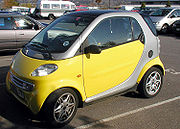
Straddling the boundary between car and motorbike, these vehicles have engines under 1.0 litre, typically seat only two passengers, and are sometimes unorthodox in construction. Some microcars are three-wheelers, while the majority have four wheels. Microcars were popular in post-war Europe, where their appearance led them to be called "Bubble cars". A descendant of the microcar is the modern Smart Fortwo.
Examples of microcars:
- Isetta
- Messerschmitt microcar
- Subaru 360
Hatchbacks, saloons (sedans) and estate cars (station wagons)
City car
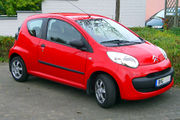
A city car is a small automobile intended for use in urban areas. Unlike microcars, a city car's greater speed, capacity and (in perception at least) occupant protection are safer in mixed traffic environments and weather conditions. While city cars can reach highway speeds, that is not their intended use. In Japan, city cars are called kei cars. Kei cars have to meet strict size and engine requirements: engines have a maximum displacement of 660 cc and the car's length must be under 3400 mm.
Examples of kei cars:
- Daihatsu Move
- Honda Life
- Suzuki Cervo
Examples of city cars:
- Fiat Panda
- Ford Ka
- Citroen C1
Supermini/subcompact car
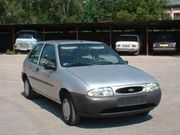
This class is known as supermini in Europe, subcompact in North America. Superminis have three, four or five doors and are designed to seat four passengers comfortably. Current supermini hatchbacks are approximately 3900 mm long, while saloons and estate cars are around 4200 mm long.
In Europe, the first superminis were the Fiat 500 of 1957 and the Austin Mini of 1959. Today, superminis are some of the best selling vehicles in Europe.
In Australia, the motoring press tends to distinguish between a light car such as the Daihatsu Charade or early models of the Holden Barina, and slightly larger models such as the Ford Fiesta which is considered to be a small car. As the general size of vehicles in this class has gradually increased, the category of light car has almost disappeared.
Examples of superminis / subcompact cars:
- Ford Fiesta
- Opel Corsa
- Volkswagen Polo
This category is equivalent to the EuroNCAP class "Superminis".
Small family car/compact car
Small family/compact cars refer to the longest hatchbacks and saloons and estate cars with similar size. They are approximately 4250 mm long in case of hatchbacks and 4500 mm in the case of saloons and estate cars. Compact cars have room for five adults and usually have engines between 1.4 and 2.2 litres, but some have engines of up to 2.5 litres. These are the most popular vehicles in most developed countries.
Examples of hatchback small family cars/compact cars:
- Ford Focus
- Toyota Corolla
- Volkswagen Golf
This category is equivalent to the EuroNCAP class "Small Family Cars". In Australia, this class is generally referred to as being small-medium sized cars.
Large family car/mid-size car

Large family/mid-size cars have room for five adults and a large trunk (boot). Engines are more powerful than small family/compact cars and six-cylinder engines are more common than in smaller cars. Car sizes vary from region to region; in Europe, large family cars are rarely over 4700 mm long, while in North America, Middle East and Australasia they may be well over 4800 mm. Examples of large family cars/mid-size cars:
- Ford Mondeo
- Citroen C5
- Toyota Camry
This category is equivalent to the EuroNCAP class "Large Family Cars". These are known in Australia as Medium sized cars.
Full-size car/large car

This term is used most in North America, Middle East and Australia where it refers to the largest sedans on the market. Full-size cars may be well over 4900 mm long and are the roomiest vehicles.
Examples of full-size cars:
- Chrysler 300/Dodge Charger
- Ford Crown Victoria
- Toyota Avalon
Compact executive car/entry-level luxury car
These are luxurious equivalents to mid-size and compact cars. Powerful four-, six- and even eight-cylinder engines are available but, rear seat room and trunk space are more reduced than in more common executive or luxury vehicles simply because of their smaller size and sport characteristics. Examples of compact premium cars / entry-level luxury cars:
- BMW 3 Series
- Lexus IS
- Acura TSX
This category is equivalent to the EuroNCAP class "Large Family Cars".
Executive car/mid-luxury car
An executive car or mid-luxury car is larger than a large family car/mid-size car and a compact executive car/entry-level luxury car. They are usually very roomy, powerful and luxurious, making them more expensive than "standard" saloons.
Examples of executive cars/mid-luxury cars:
- Audi A6
- Jaguar XF
- Mercedes-Benz E Class
This category is equivalent to the EuroNCAP class "Executive Cars".
Full-size luxury car/Grand saloon
A full-size car is typically a four-door saloon. These are the most powerful saloons, with six, eight and twelve-cylinder engines and have more equipment than smaller models.
Examples of full-size cars:
This category is equivalent to the EuroNCAP class "Executive Cars".
Sports cars and grand tourers
Hot hatch / sport compact
A hot hatch or sport compact is a high-performance small car, usually a hatchback, based on standard superminis or small family cars with improved performance, handling and styling. Hot hatches are very popular in Europe, and originated from the original Volkswagen Golf GTI. In North America, sport compacts are usually sold as saloons or coupés rather than hatchbacks.
Examples of hot hatches/sport compacts:
- Citroen Saxo VTR
- Honda Civic Type R
- Volkswagen Golf GTI
Sports saloon / sports sedan / Luxury Sports
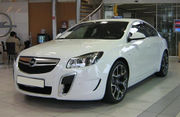
These are high performance versions of saloons. Sometimes originally homologated for production based motorsports (touring cars) and like regular saloons, seats four or five people.
Examples of sports saloons/sedans:
- BMW M5
- Dodge Charger SRT-8
- Ford Mondeo ST200
Examples of sport compact saloons/sedans:
- Dodge SRT-4
- Nissan Sentra V-spec
- Mitsubishi Lancer Evolution
Examples of luxury: Sports:
Sports car

This small-size vehicle class combines performance and handling. Sometimes inspired by racing vehicles, this class ranges from lightweight derivatives such the Lotus Elise and "average consumer" focused models such as the Mazda Miata, to heavier and more powerful models such as the Dodge Viper.
Examples of sports cars:
- Chevrolet Corvette
- MG T-type
- Porsche 911
Grand tourer

Larger, more powerful and heavier than sports cars, these vehicles typically have a FR layout and seating for four passengers (2+2). These are more expensive than sports cars but not as expensive as supercars. Some grand tourers are hand-built.
Examples of grand tourers:
- Aston Martin DB9
- Lexus SC300/400
- Ferrari 612 Scaglietti
Supercar

Supercar is a term generally used for ultra-high-end exotic cars, whose performance is superior to that of its contemporaries. The proper application of the term is subjective and disputed, especially among enthusiasts.
Muscle car
The muscle car term refers to a variety of high-performance vehicles, mainly affordable 2-door rear wheel drive mid-size cars with powerful V8 engines, that were most often made in the United States.[6][7] Although opinions vary, it is generally accepted that classic muscle cars were produced in the late 1960s and early 1970s.[8][9][10][11] Muscle cars were also produced in Australia and other nations.
Examples of American muscle cars from the 1960s and 1970s:
- Ford Torino
- Plymouth Road Runner
- Pontiac GTO
Examples of Australian muscle cars:
- Ford Falcon
- Holden Monaro
- Valiant Charger
Pony car
The pony car is a class of automobile launched and inspired by the Ford Mustang in 1964. It describes an affordable, compact, highly styled car with a sporty or performance-oriented image.[12][13]
Examples of American pony cars (and some automotive journalists state that "Pony Cars are an expressly American creation")[14]:
- AMC Javelin
- Chevrolet Camaro
- Dodge Challenger
Convertible
A car that features a flexibly operating roof for open or enclosed mode driving. Also known as a cabriolet or roadster.
Examples of convertibles:
- Honda S2000
- Volkswagen Eos
- Volvo C70
Off-roaders
Off-road vehicles, or "off-roaders" are sometimes referred to as "four wheel drives", "four by fours", or 4x4s — this sometimes happens colloquially in cases where certain models or even an entire range does not possess four-wheel drive.
Sport utility vehicle
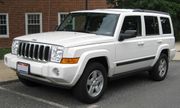
Sport utility vehicles are off-road vehicles with four-wheel drive and true off-road capability. They most often feature high ground clearance and an upright, boxy body design. Sport Utilities are typically defined by a body on frame construction which offers more off-road capability but reduced on-road ride comfort and handling compared to a cross-over or car based utility vehicle.
Examples of SUVs:
- Ford Explorer
- Land Rover Discovery
- Jeep Grand Cherokee
This category is equivalent to the EuroNCAP class "Large Off-Roaders".
Crossover SUV
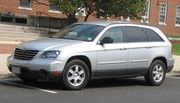
Crossover SUVs are derived from an automobile platform using a monocoque construction with light off-road capability and lower ground clearance than SUVs. They may be styled similar to conventional "off-roaders", or may be look similar to an estate car or station wagon.
Examples of crossover SUVs:
- BMW X5
- Chevrolet Equinox
- Lexus RX
This category is equivalent to the EuroNCAP class "Small Off-Roaders".
Multi-purpose vehicles / Minivans
Also known as "people carriers", this class of cars resembles tall estate cars. Larger MPVs may have seating for up to eight passengers. (Beyond that size, similar vehicles tend to be derived from vans (see below) and in Europe are called minibuses.)
Being taller than a family car improves visibility for the driver (while reducing visibility for other road users) and may help access for the elderly or disabled. They also offer more seats and increased load capacity than hatchbacks or estate cars.

Examples of mini MPVs:
- Daihatsu Grand Move
- Citroen C3 Picasso
- Opel/Vauxhall Meriva
Examples of compact MPVs:
- Chrysler PT Cruiser
- Fiat Multipla
- Ford C-MAX
Both categories are equivalent to the EuroNCAP class "Small MPVs".
Examples of large MPVs / minivans:
- Chrysler Voyager
- Ford Galaxy
- Toyota Sienna
This category is equivalent to the EuroNCAP class "MPVs".
Van, camper, RV, minibus etc.
In some countries, the term "van" can refer to a small panel van based on a passenger car design (often the estate model / station wagon); it also refers to light trucks, which themselves are sometimes based on SUVs or MPVs. (But note that those retaining seats and windows, while being larger and more utilitarian than MPVs, may be called "minibuses".) The term is also used in the term "camper van" (or just "camper") — equivalent to a North American recreational vehicle (RV).
In the United States, the term "van" refers to vehicles that, like European minibuses, are even larger than large MPVs and are rarely seen being driven for domestic purposes — except for "conversion vans". These possess extremely large interior space and are often more intended for hauling cargo than people. Most vans use body-on-frame construction and are thus suitable for extensive modification and coachwork, known as conversion. Conversion vans are often quite luxurious, boasting comfortable seats, soft rides, built-in support for electronics such as television sets, and other amenities. The more elaborate conversion vans straddle the line between cars and recreational vehicles.
Examples of North American "vans":
- Dodge Ram Van
- Ford E-Series
- GMC Savana
Examples of European "vans":
- Ford Transit
- Volkswagen Transporter
- Mercedes-Benz Sprinter
Car show class definitions
A different classification system is used for purposes of differentiating vehicles in most car shows. While there is little doubt about the definition of classes that are self-described such as "Mustang" or "Firebird", there is often confusion about the definition of classes that are not as readily understood. The following classes are often used in car shows across America - the definitions are determined either by state regulations, the National Street Rod Association, or have been gathered from other reliable sources:
- Street Rod —A motor vehicle, or a reproduction thereof, with a model year of 1948 or older which has been materially altered or modified by the removal, addition or substitution of essential parts and with a gross weight or registered gross weight of not more than 9,000 pounds.
- Classic car —A motor vehicle, but not a reproduction thereof, at least 30 years old, not materially altered or modified by the removal, addition or substitution of essential parts except that such parts represent the original
- Hot Rod - Any car rebuilt or modified for higher speed, faster acceleration, or a sportier look. Many automobiles may be called hot rods, including some used in drag racing. They may be composed of used or newly fabricated parts. Can be a kit car.
- Custom car - a factory-built vehicle that has been modified in either to improve its performance, often by altering or replacing the engine and transmission, or it may be a personal design by the builder, making the car look unique and unlike any car that might have been factory built. Though distinct from hot rods there is debate among customizers and rodders as to where the line should be drawn. A Custom Car cannot be a kit car, as a kit car is not a factory-built vehicle that has been modified from the original configuration.
- Antique car — A motor vehicle, but not a reproduction thereof, at least 25 years old, which has been maintained in or restored to a condition which is substantially in conformity with manufacturer specifications and appearance.
- Special Interest - a vehicle uniquely distinguishable from the usual, or designed for a particular purpose (i.e. fire truck, MASH jeep, tank, surf wagon, bus, race cars etc.) which would pique the interest of the public at large because of its uniqueness or specialty function.
- Kit car - any vehicle that is created primarily from kit or prefabricated parts, and is a reproduction or replica. An original factory-built vehicle that utilizes prefabricated fiberglass body units to replace worn or damaged original parts is not a kit car.
- Brass Era car - beginning with the first horseless carriages, named for the brass fittings used for such things as lights and radiators. Starting with the first commercial automobiles of the 1890s to about 1918-19. Includes most Edwardian cars
- Veteran car - any motor vehicle built prior to 1905
- Edwardian car - any vehicle built from 1905 - 1918. Includes all brass era cars
- Vintage car - commonly defined as a car built between 1919 and 1930. The Classic Car Club of America prefers 1925 since it is the pre-classic car period.
- Pre-war car - beginning with the Great Depression in 1930 and ending after WWII, usually placed at 1948
See also
- ACRISS Car Classification Code
- Automobile
- Car safety and road safety
- Car body style
- Three wheeled car
- Truck classification
- Vehicle size class
References
- ↑ How are vehicle size classes defined? FuelEconomy.gov, part of the U.S. Department of Energy
- ↑ Canadian Environmental Protection Act, 1999 Canada Gazette
- ↑ VFACTS Motor Vehicle Classifications and Definitions Australian FCAI - Federal Chamber of Automotive Industries
- ↑ European Commission classification
- ↑ NCAP Comparable cars
- ↑ Koch, Jeff. "The First Muscle Car: Older Than You" Hemmings Muscle Machines - October 1, 2004, retrieved on 2008-06-30.
- ↑ The Merriam-Webster definition: "any of a group of American-made 2-door sports coupes with powerful engines designed for high-performance driving."car "muscle car." Merriam-Webster Online, retrieved on 2008-06-30.
- ↑ "Muscle Car Definition" Muscle Car Club Muscle, undated, retrieved on 2008-06-30.
- ↑ Sherman, Don. "Muscle Cars Now Worth Millions" The New York Times, June 4, 2006, retrieved on 2008-06-30.
- ↑ Classic Muscle Cars Library, How Stuff Works, undated, retrieved on 2008-06-30.
- ↑ "Muscle Car Definition" by Muscle Car Society, undated, retrieved on 2008-06-30.
- ↑ Gunnell, John (2005). American Cars of The 1960s: A Decade of Diversity. Krause Publications. pp. 47–50. ISBN 978-0896891319.
- ↑ "Pony Car History" undated, retrieved on 2008-06-30.
- ↑ Roy, Rex. "Car culture: A child's Pony Car education essential" The Detroit News, February 27, 2008, retrieved on 2008-06-30.